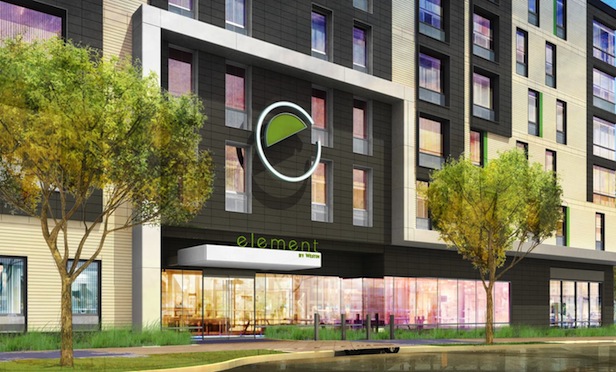 A dual-branded Element and Aloft opened in Boston’s Seaport District in February, part of what Marcus & Millichap predicts will be a 1.6% increase in domestic supply this year.
A dual-branded Element and Aloft opened in Boston’s Seaport District in February, part of what Marcus & Millichap predicts will be a 1.6% increase in domestic supply this year.
CALABASAS, CA—Last year was one for the record books as far as the US hotel sector was concerned, as it hit new highs in terms of room nights, room revenue and annual occupancy. However, Marcus & Millichap notes that 2015 also set in motion a number of trends which could translate into moderating growth in 2016.
Last year’s supply growth of 1.1% was below the long-term average, yet it marked “the greatest rate of growth during the current expansion,” according to the 2016 US Hospitality Investment Forecast from Marcus & Millichap. “Brands continue to open new locations and a large construction pipeline remains in place, potentially disrupting the performance of existing properties when new rooms come on line.”
The pace of supply growth is expected to pick up this year; Marcus & Millichap notes that available rooms will rise 1.6% by year’s end, primarily through the completion of new properties, the fastest growth rate in eight years. “More than 110,000 rooms are scheduled for completion in 2016, and several thousand additional rooms are in the final phase before groundbreaking,” the report states.
Last year’s volume of completions also reduced the rate of growth in US occupancy and RevPAR, says MMI. The trend was most evident in the 25 largest markets, where construction is concentrated.
Four of the 25 largest markets recorded double-digit RevPAR growth in ’15. By contrast, nearly half the top 25 saw such double-digit gains in the preceding year.
“The US hotel sector has reached a turning point,” according to the report. “Following several years of rising occupancy, new supply will finally accelerate sufficiently to balance demand.”
Yet the report also makes it clear that continued growth is in the cards for the seventh year in a row, if not at quite the same pace the hotel sector saw in the preceding six years. Marcus & Millichap predicts that continued growth in the US economy will support elevated travel volume that will drive a 2.1% bump in room nights during the year. As a result, annual occupancy will inch up 30 basis points to 65.9%.
And Marcus & Millichap’s report sees growth this year exceeding last year’s in one important metric. “Property owners will continue to wield considerable pricing power, resulting in a 4.5% percent rise in yearly ADR that will narrowly outpace last year’s 4.4% bump,” according to the report.
Beyond that, however, Marcus & Millichap cautions that realizing more substantial rates of growth may prove elusive, “especially on primary travel days or during peak periods where properties are already operating at full capacity.” Other downside risks cited in the firm’s report pertain to a potential decline in inbound foreign travel related to the strong US dollar.
Then there are new challenges, including home-sharing services such as Airbnb. “In addition, hotels will face continued wage pressure in the coming year as several municipalities consider mandatory minimum wage increases,” the report states.
Notwithstanding the potential pressures on growth, Marcus & Millichap sees plenty of continued investor interest in lodging properties this year, especially in the select-service market segment. “Lean operating models and the significant flow-through of revenue to the bottom line will sustain interest in the select-service segment in 2016,” according to the Hospitality Investment Forecast.

















 Copyright © 2024 ALM Global, LLC. All Rights Reserved.
Copyright © 2024 ALM Global, LLC. All Rights Reserved.